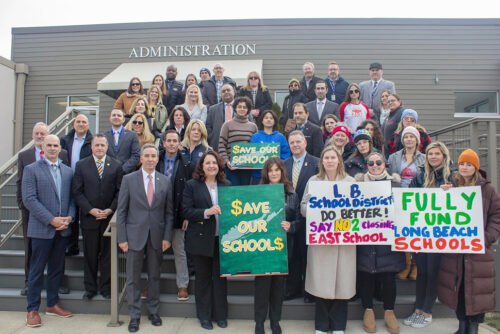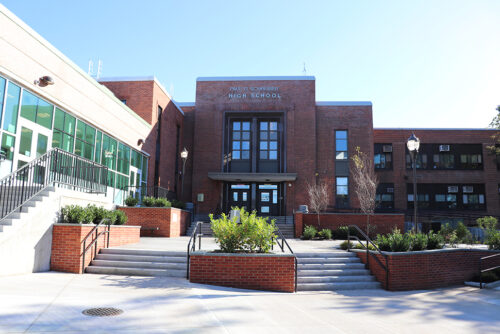Changes to school funding calculation add up to uncertainty for many districts
Foundation Aid, first enacted in 2007-08, is the largest unrestricted aid category supporting public school district expenditures in New York State. This year it represents approximately 68.4 percent of the total State Aid received by districts statewide. Foundation Aid is the package of funding the state provides each school district. It is based on a complicated formula that takes enrollment, need, and federal and local contribution into account, among other factors. This past year is the first where Foundation Aid has been fully funded. Additionally, parts of the formula for Foundation Aid have not been updated for more than 15 years.
The state is facing a $4.3 billion dollar shortfall in the coming fiscal year. The two biggest expenditures for the budget are healthcare and public education, making them the first places considered for cuts. The state office of the budget stated that the decision to change the formula and eliminate the save harmless provision was based on a number of factors. “This budget attempts to solve for a $4.3 billion budget gap and we need to make decisions on where to spend state resources. With regard to public schools, they’ve never been more well-resourced. In a time when we are paying $35 billion for schools, we have to ask, ‘are we investing it appropriately?’ Are we making sure our high need students are getting the resources they need and that districts that are growing in size have the resources they need, while also getting to a number that is sustainable in the State’s financial plan,” said New York State Budget Director Blake Washington.
At a budget hearing at the end of January, New York State Education Department Commissioner Betty Rosa did not approve of the governor’s plan to do away immediately with “save harmless,” also known as “hold harmless,” and the establishment of an inflation factor of 2.4 percent for Foundation Aid. She stated that she preferred the elimination of “save harmless” be phased in to give the districts time to make adjustments and find other funding.
“We do not support this position because it impacts 337 districts. It’s been so abrupt and the conversations have not taken place. Our position has been that in order to do this, you really should have a three-to-five-year plan, where we have opportunities to get a new formula, where we have opportunities to look at the impact across the entire state in the various districts and make sure that the new formula informs the study and the new formula informs the work,” Commissioner Rosa said in her testimony.
The loss of federal funding from COVIDera aid is also compounding the issue. Rosa stated that she had been warning districts to be ready for this funding “cliff” for some time. “We have been warning districts about the fiscal cliff from last year, the year before, knowing that the additional financials that we received for learning loss that were added, with staffing and everything else (were ceasing.) I think a lot of districts were caught off guard, knowing that we’re going through that process of the Federal financial cliff, and then having this also happen. This has really created distress for districts. Now they have to rethink how they deal with personnel issues, delivery of services for our students, as well as looking at what are the decisions that they’re going to have to make this spring.”
A number of representatives from Nassau County, including New York State Senator Steve Rhoads, Senator Patricia Canzoneri- Fitzpatrick, Senator Jack Martins, Senator Alexis Weik and Assembly Members Ari Brown and Brian Curran, have responded to the proposed changes. The group gathered at the beginning of the month to call on the governor to reconsider and have also started a petition.
“There were superintendents there from across Nassau County,” Martins said. “Whether they’re on the South Shore, whether they’re on the North Shore, they all have the same concern: if the state if going to provide us with these mandates… it’s time that the state takes on the responsibility of properly funding education here on Long Island.”
Martins cited an example of the state withholding funding if there’s a decline in enrollment, explaining that a loss of, say, 20 students in various grades wouldn’t change the district’s budget .
“The state, through the governor’s proposal and the rolling back of the ‘hold harmless,’ is basically saying, ‘we’re going to cut back on our funding’ when effectively it doesn’t change the budget for that school district,” Martins said. Martins also expressed concern about the Consumer Price Index piece of the formula for calculating Foundation Aid.
“The governor decided because we’ve had a rough inflationary period, rather than increasing to inflation, she would actually take an average over the last several years,” Martins said. “That inflation has impacted every one of our school districts, their cost of energy, materials, everything they do has been impacted by that cost of inflation”
Martins added that because of the tax cap, and these rises in costs, districts have to rely on the state to “pay its fair share.”
“They’re not getting the fair proportionate share of their budget from the state, but all of these mandates come down from the state every year,” Martins said. “And I’ve heard that from every superintendent across this district.”
Martins said that the New York State Senate and Assembly will be releasing their own budgets.
“There will be alternatives there,” Martins said. “And I think you’ll see that both the Assembly and the Senate will address education differently.”
Other public officials have also weighed in on the changes. “For the past three years, New York State has made a historic commitment to fully fund Foundation Aid, and these investments should not be undermined now. I will not let that happen. I am committed to joining my colleagues in the Democratic Assembly and Senate Majorities to remove the proposed cuts from the final budget. Similar to past years’ negotiations, this would be done during the final budget process. While others make statements and hold press conferences, I will be working with my colleagues in the Assembly Majority to put forth a budget that makes sure our schools receive the critical funding they need. As we have always done,” said Assemblywoman Gina Sillitti in a statement.
The New York State Union of Teachers is also concerned about the impact the recalculation will have on education in the state. “Call them what you want; these are cuts,” said NYSUT President Melinda Person. “Once again, the state is turning its back on its support for our students and our communities. It took less than a year after the legacy victory of fully funding Foundation Aid for that promise to be broken, and we now return to the same old fight for the resources all our schools desperately need. To say we are profoundly disappointed is an understatement.”
For more information on the budget, visit budget.ny.gov.
Troubled Foundation

Public officials and representatives from multiple school districts hope to influence Governor Hochul’s budget.
(Photo by the Office of Senator Steve Rhoads)






























